Observation of Solar Radiation
Principles and theory of measurement
All materials emit radiation (electromagnetic waves) in proportion to the fourth power of their temperature. Solar radiation is radiative energy in the wavelength range of 0.29 - 3 μm. It accounts for about 97% of all radiative energy from the sun, whose surface temperature is about 6,000 K. Around 50% of its energy is concentrated into a wavelength region visible to the human eye.
The two types of instruments used for observing solar radiation at the Aerological Observatory are 1) those that measure solar energy integrated over a wide wavelength range, and 2) those that measure spectral solar irradiance at specific wavelengths. The former are thermopile sensors such as pyrheliometers and pyranometers, which convert incoming solar energy into thermal energy and output a voltage proportional to solar radiation in line with the thermoelectric effect. The latter type disperses solar light via an optical filter, diffraction grating or similar, and photodiodes or photodiode arrays are often used to measure the irradiance of the dispersed light. Spectral solar irradiance data obtained using a sunphotometer are adopted for aerosol optical depth calculation by the Aerological Observatory (Observation of Atmospheric Optical Depth).
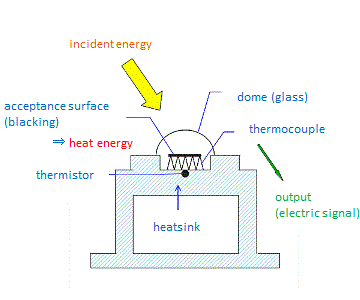
Concept of radiative energy-measuring instruments
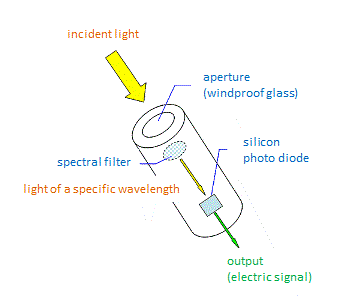
Concept of spectral radiative energy-measuring instruments
(Filter-type sunphotometer)
Observation types
- Direct solar radiation
- This is solar energy that directly reaches the earth's surface from the sun. It is defined as direct solar energy per unit area of a plane perpendicular to a direct solar beam.
- Diffuse solar radiation
- This is solar energy that reaches the earth's surface from all directions of the sky via diffusion and reflection by way of an atmospheric component. It is defined as the diffused solar energy arriving per unit area on a horizontal plane.
- Global solar radiation
- This is the total solar energy that reaches the earth's surface from all directions of the sky. It is defined as the total solar energy arriving per unit area on a horizontal plane.
- Reflected solar radiation
- This is solar energy that reaches the earth's surface and is then reflected upward. It is defined as the total upward solar energy arriving per unit area on a horizontal plane.
Observation methods
Pyrheliometers and pyranometers are used for observation of solar radiation. Solar energy absorbed at the thermopile sensor of an instrument is converted to heat, and the sensor then generates a voltage output. The sensor is covered with a glass dome to eliminate the effects of wind and rain. Ventilation equipment is also provided to improve measurement stability.
- Direct solar radiation
- This type of radiation is observed using a pyrheliometer mounted on a solar tracker to ensure that sun beams are directed toward the instrument throughout the year.
- Diffuse solar radiation
- This type of radiation is observed using a pyranometer horizontally mounted on a solar tracker with its glass dome shaded from solar beams.
- Global solar radiation
- This type of radiation is observed using a pyranometer mounted horizontally. It is known that pyranometer errors are caused by the elevation angle and azimuth of the sun. To significantly reduce such errors, the Aerological Observatory calculates global solar radiation as the sum of the horizontal component of direct solar radiation and diffuse solar radiation.
- Reflected solar radiation
- This type of radiation is observed using a pyranometer mounted horizontally downward on a pole above the ground at a height of 1.5 - 2 m.
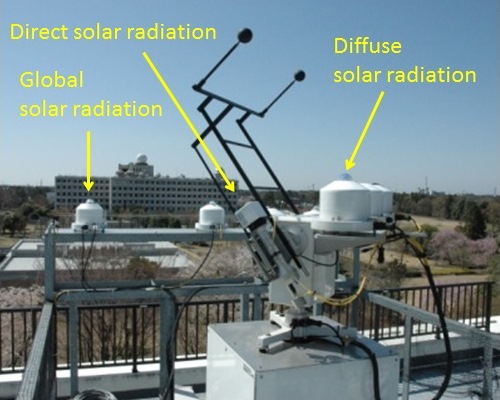
Observation of solar radiation at the Aerological Observatory
Left: global solar radiation observation; center: direct solar radiation observation; right: diffuse solar radiation observation
Observation results
Solar radiation observation data are acquired in one-second samplings from sunrise to sunset every day, and their quality is checked to meet the requirements of the Baseline Surface Radiation Network (BSRN). Examples of observation data from Tsukuba are shown below.
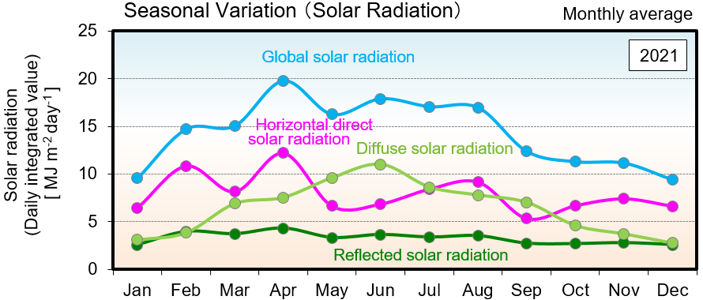
Seasonal variations of monthly average solar radiation at Tsukuba (2021)
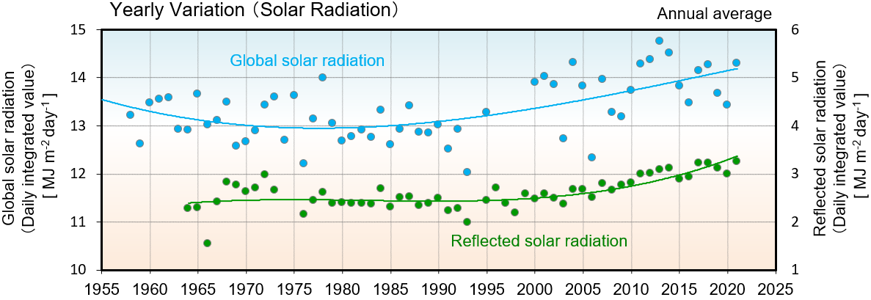
Long-term variations of annual average solar radiation at Tsukuba